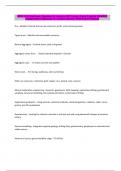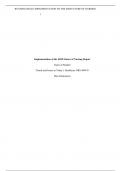APSC 151 Final Exam | Questions & Answers (100 %Score) Latest Updated 2024/2025
Comprehensive Questions A+ Graded Answers | With Expert Solutions
Ore - Metallic minerals that can be mined at a profit, rock containing metal
Types of ore - Metallic and nonmetallic resources
Natural aggregate - Crushed stone, sand, and gravel
Aggregate comes from... - Glacial outwash deposits in Canada
Aggregate used... - To make concrete and asphalt
Stone used... - For facings, walkways, and countertops
Other ore resources - Diamond, gold, copper, zinc, potash, coal, uranium
Mineral exploration engineering - Research, geophysics, field mapping, exploration drilling, geochemical
sampling, structural modelling, 3D orebody estimation, confirmation drilling
Exploration geophysics - Using seismics, electrical methods, electromagnetism, radiation, radar, micro-
gravity, and 3D visualization
Geochemistry - Looking for indicator minerals in soil and rock and using elemental isotopes to examine
history
Reserve modelling - Integrates regional geology, drilling data, geochemistry, geophysics to estimate total
viable reserve
Amount of core to get to feasibility stage - 75-150 km
,Types of deposits - Magmatic, porphyry, volcanic, hydrothermal, sedimentary, placer
Magmatic deposits - Some metals enriched and concentrated during magma cooling, heavy minerals
crystallize early and concentrate at bottom of magma chamber (e.g. chromite, iron, magnetite)
Porphyry orebodies - Magmatic and hydrothermal (hot water) - form as liquid and gas volatiles change
chemical state and change saturation limit for sulphide minerals
Copper porphyry - Cyclical magmatic intrusion with alteration by volcanic waters
Volcanic deposits - Violent kimberlite eruptions bringing diamonds from upper mantle to surface
Epithermal volcanic deposits - Near surface deposits precipitated from hot volcanic waters
What causes different ore types? - Interaction with temperature, pressure, volatile gases, and solution
as magma rises
Hydrothermal deposits associated with igneous activity - Hot groundwater dissolves metals in the
presence of salts and hydrothermal fluids move along fractures, cool, and deposit them as orebodies
Black smokers - type of hydrothermal deposit - Seawater gushes from seafloor near spreading centres
and precipitates volcanogenic massive sulphide deposits - deformed by tectonics
Vein deposit - type of hydrothermal deposit - Hydrothermal fluids move along fractures, cool, and
precipitate metallic ions
Disseminated deposit - type of hydrothermal deposit - Precipitation distributed throughout the rock
body
Sudbury Astrobleme - 10-15 km wide asteroid impact orebody - impacted rocks contained lots of
sulphides which extracted Ni, Cu, and Pt elements
, Sedimentary deposits - During development of Earth's atmosphere, oxygen reacted with iron dissolved
in seawater and caused it to precipitate on seafloor
Placer deposits - Any deposit that accumulates in loose form due to sedimentation or where ore has
been eroded from one primary source to be further concentrated and redeposited elsewhere
Mining - Extracting essential natural resources locked in crustal rock
Mineral resource - Elements, compounds, minerals, or rocks concentrated in a form that can be
extracted to obtain a useable commodity
Ore reserve - Confirmed portion of resource that can be extracted at a profit
Exploration for making a reserve - Confirmation drilling and assaying (quantifying amount of metal
accessible)
Economic factors when making a reserve - Size and grade of deposit, mineralogy (mining and processing
feasibility), metal price (main risk), corporate strategy
Steps in gold extraction - Mining, crushing, transport, grinding and sizing, leaching and adsorption,
elution and electrowinning, bullion production, water treatment, tailings disposal
Smelting - Extracting metal from ore using heat and melting
Overburden - type of mine waste - Material above orebody
Waste rock - type of mine wate - Barren part of orebody
Tailings - type of mine waste - Silt sized waste from grinding
Slag - type of mine waste - Waste from smelting





